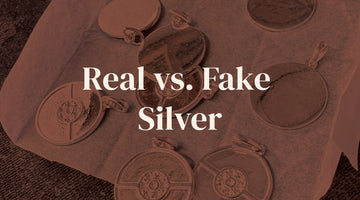ancient civilizations to starring in your grandma's jewelry collection. But as with anything valuable, there are always tricksters out there trying to pass off something fake as the real deal. So, how do you tell if that shiny piece of silver you just bought is genuine or a cleverly disguised impostor? Let's dive into the world of real vs. fake silver, armed with a bit of humor and a healthy dose of skepticism.
Also Read: Platinum or Diamond: Which One Will Leave Your Wallet Weeping?
1. The Weight Test: Real Silver Isn’t on a Diet
Silver might be precious, but it’s not exactly lightweight. If you’re holding a piece of silver jewelry or a coin, it should have a certain heft to it. Real silver is dense—10.49 grams per cubic centimeter, to be precise. It’s got that satisfying weight, like when you lift a burger that’s way bigger than you expected. Fake silver, on the other hand, often feels a bit like that disappointing salad your health-conscious friend insisted you try—light and unsatisfying.
Try this: Compare the weight of your silver item to a piece of known real silver of similar size. If it feels like it’s been skipping leg day, you might be dealing with a fraud.
2. The Magnet Test: Real Silver Doesn’t Get Attached Easily
If there’s one thing silver is, it’s non-magnetic. Real silver doesn’t get clingy—it’s like the independent, self-assured friend who doesn’t need to latch onto anyone (or anything). So, grab a magnet and see if your silver is attracted to it. If it sticks, you’ve probably got a faker on your hands.
But beware: Some fake silver items are made from non-magnetic metals like brass or stainless steel. In these cases, the magnet test might not expose the lie, but it’s still a quick and easy check worth trying.
Also Read: Jewelry Care Tips: Keeping Your Bling Sparkling Like It's Fresh Outta Wakanda
3. The Sound of Silver: Listen Carefully
Ever tapped on a real silver coin or piece of jewelry? It’s got a distinct, bell-like ring to it. Kind of like that satisfying ding you hear when you finally score a table at a packed restaurant. Fake silver, on the other hand, sounds duller—more like a half-hearted applause after a terrible joke.
Try this: Gently tap your silver piece with another metal object and listen closely. A long, clear ring indicates real silver, while a short, muted clunk might suggest otherwise.
4. The Ice Test: Cool as Real Silver
Silver is an excellent conductor of heat. When you place an ice cube on a piece of real silver, the ice should start melting almost immediately. It’s like putting on your favorite Netflix show and suddenly losing track of time—silver works its magic fast. Fake silver, however, is more like that Wi-Fi connection that takes forever to buffer—it just doesn’t get the job done.
Try placing an ice cube on your silver piece and watch how quickly it melts. If the ice is taking its sweet time, your silver might be less precious than you thought.
Also Read: The Ultimate Guide to Types of Diamonds: More Than Just a Girl's Best Friend
5. The Nitric Acid Test: The Ultimate Silver Smackdown
This one’s not for the faint-hearted (or the chemistry-challenged). Nitric acid can reveal the truth about your silver in a way that’s hard to argue with. When a drop of nitric acid is placed on real silver, it will turn a creamy white color. Fake silver, however, reacts differently—typically turning green or brown, exposing the less noble metals beneath the surface.
But a word of caution: This test can damage your silver if it’s real, so it’s usually a last resort. Think of it like the relationship talk—only go there if you absolutely must.
6. Hallmarks: The Telltale Signs of Real Silver
Hallmarks are like the designer label on your favorite pair of jeans. They’re the little symbols or stamps that tell you where your silver came from and what it’s made of. Genuine silver will often be stamped with a hallmark indicating its purity—look for marks like “925” (which means 92.5% silver, the rest usually being copper), “Sterling,” or even country-specific marks.
But be careful—just like there are knock-off designer bags, there are fake hallmarks too. Always check these marks carefully, and if in doubt, consult a professional.
Also Read: 7 Common Jewelry Shopping Mistakes and How to Avoid Them
7. The Scratch Test: Real Silver Shows Its True Colors
If you’re okay with potentially leaving a mark on your item, the scratch test is another method to distinguish real silver from fake. Gently scratch the piece in an inconspicuous area. Real silver will reveal a bright, metallic layer underneath. Fake silver might show a different color, like copper or a dull gray, indicating that it’s just a silver coating over a cheaper metal.
But remember, this method can leave a scratch on your item—so proceed with caution!
8. The Smell Test: Fake Silver Smells Fishy
Real silver doesn’t have a strong odor. If your silver item smells like pennies or has a metallic scent, that’s a red flag. This is especially common with items that are silver-plated or made from other metals like copper. Think of it like this: Real silver is like that cool, calm, and collected friend who never sweats under pressure. Fake silver? It’s the one who’s sweating bullets before the exam.
Pop Culture Reference: When Real Silver Meets the Big Screen
Remember the classic movie "Pirates of the Caribbean"? Our man Captain Jack Sparrow would have had a field day with this knowledge. Imagine him waving his compass around not for treasure, but to spot fake silver doubloons from the real ones. Just like Jack had his wits and his rum, you’ve now got the tools to outsmart the modern-day pirates trying to pass off fake silver as the real McCoy.
Conclusion: Trust, but Verify
In a world where appearances can be deceiving, knowing how to distinguish real silver from fake silver is more important than ever. Whether you’re a seasoned collector, a casual buyer, or just someone who likes shiny things, these tests can help you avoid being fooled. After all, no one likes being taken for a ride—especially when it involves something as precious as silver.
So next time you’re eyeing that glittering piece of jewelry or shiny coin, don’t just trust your eyes—get hands-on, do a little testing, and channel your inner Captain Jack Sparrow. Who knows? You might just uncover a treasure trove of real silver—or save yourself from being duped by a cheap imitation. Either way, you’ll come out ahead, and maybe with a great story to tell at your next pirate-themed party. Cheers to that!

